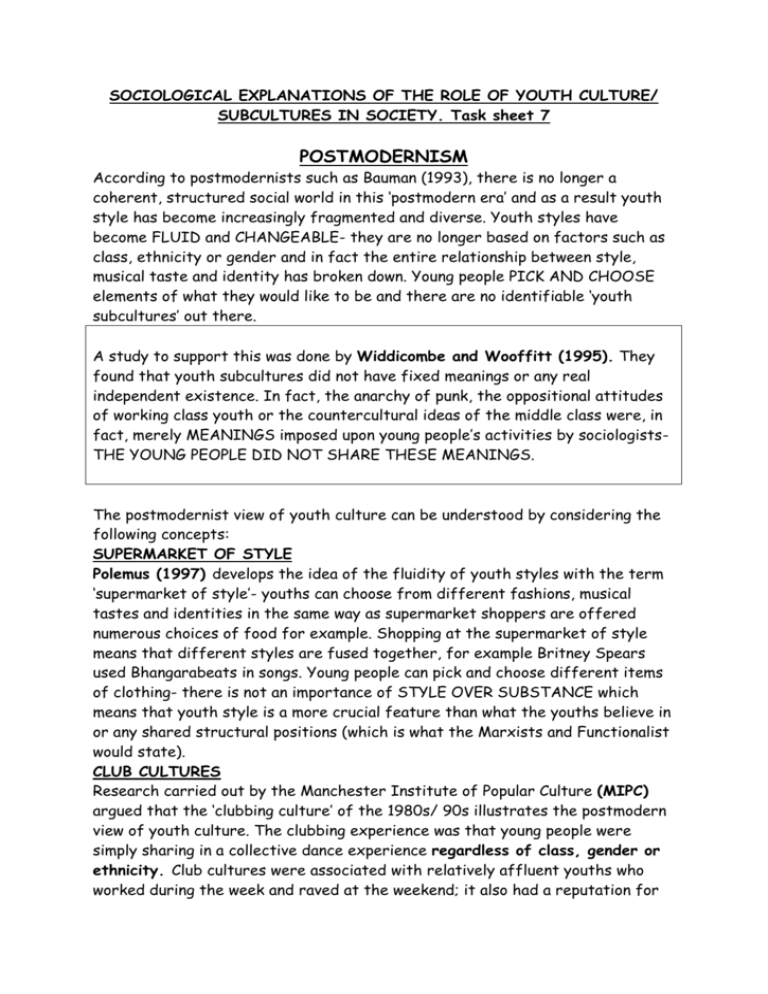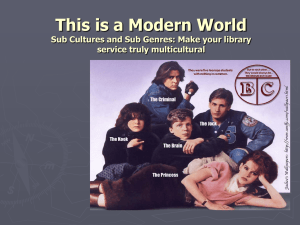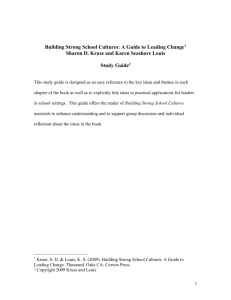Post Modernism and Youth handout 2014
advertisement

SOCIOLOGICAL EXPLANATIONS OF THE ROLE OF YOUTH CULTURE/ SUBCULTURES IN SOCIETY. Task sheet 7 POSTMODERNISM According to postmodernists such as Bauman (1993), there is no longer a coherent, structured social world in this ‘postmodern era’ and as a result youth style has become increasingly fragmented and diverse. Youth styles have become FLUID and CHANGEABLE- they are no longer based on factors such as class, ethnicity or gender and in fact the entire relationship between style, musical taste and identity has broken down. Young people PICK AND CHOOSE elements of what they would like to be and there are no identifiable ‘youth subcultures’ out there. A study to support this was done by Widdicombe and Wooffitt (1995). They found that youth subcultures did not have fixed meanings or any real independent existence. In fact, the anarchy of punk, the oppositional attitudes of working class youth or the countercultural ideas of the middle class were, in fact, merely MEANINGS imposed upon young people’s activities by sociologistsTHE YOUNG PEOPLE DID NOT SHARE THESE MEANINGS. The postmodernist view of youth culture can be understood by considering the following concepts: SUPERMARKET OF STYLE Polemus (1997) develops the idea of the fluidity of youth styles with the term ‘supermarket of style’- youths can choose from different fashions, musical tastes and identities in the same way as supermarket shoppers are offered numerous choices of food for example. Shopping at the supermarket of style means that different styles are fused together, for example Britney Spears used Bhangarabeats in songs. Young people can pick and choose different items of clothing- there is not an importance of STYLE OVER SUBSTANCE which means that youth style is a more crucial feature than what the youths believe in or any shared structural positions (which is what the Marxists and Functionalist would state). CLUB CULTURES Research carried out by the Manchester Institute of Popular Culture (MIPC) argued that the ‘clubbing culture’ of the 1980s/ 90s illustrates the postmodern view of youth culture. The clubbing experience was that young people were simply sharing in a collective dance experience regardless of class, gender or ethnicity. Club cultures were associated with relatively affluent youths who worked during the week and raved at the weekend; it also had a reputation for drug use in general. The work of the MIPC therefore depicts youth styles that are no longer related to factors such as class, gender or ethnicity (which is what Marxists and Functionalists state!) NEO TRIBES Maffesoli (1998) suggested that youth subcultures have now ceased to exist for young people, and instead they have been replaced by FLUID and OPEN movements he calls neo-tribes. He uses this term to describe a wide range of ‘groupings’, all of which share a commitment to a communal ethic of warmth, and friendship rather than for any ‘collective purpose’ (which is what Marxists and Functionalists state!). Bennett (1999) researched clubs in Newcastle and found no evidence for youth subcultures- instead he found a loose, fluid and relatively short term youth grouping occurring. These ‘neo tribes’ were based around fashion and lifestyle, but they did not have any shared values and they did not feel they belonged to any definable group. GLOBALIZATION AND HYBRIDIZED YOUTH SUBCULTURES Finally, an important element of postmodernist thinking about youth subcultures is that of GLOBALIZATION. Luke and Luke (2000) argue today our culture is derived from media that is global in nature, it is no longer national or local. As a result, we now have a HYBRIDIZED youth culture whereby young people take elements from the global cultures featured in the media and then adapt these according to local values, for example Asian music being adapted and included into main stream pop music that is then listened to by a wide variety of young people. Cashmore (1997) study of ‘gansta rap’ illustrates the concept of youth hybridity. Gangsta rap began in 1960s Jamaica and by the 1970s it became popular in the Black neighbourhoods of New York. By the 1980’s it was promoted worldwide. However, the original rap is constantly changing and as a result it has been adapted to suit a whole variety of youth orientated circumstances. EVALUATION It could be argued that the ‘absence’ of ‘spectacular subcultures’ as identified by the CCCS would indicate that postmodernism is correct, and that we no longer use subcultures as a source of our identity. HOWEVER…there are still examples of identifiable (if not ‘spectacular’) subcultural groups in society such as goths and emos, which with their shared styles and musical tastes do fit the description of ‘youth subcultures’ and therefore the ‘fluidity’ youth identity is not entirely an accurate concept to describe all youths. Furthermore, it could still be argued that we can easily identify different genders, ethnicities and social classes by their associated styles, and therefore ‘supermarket of style’ on offer to young people has NOT led to the ‘fusion’ which cuts across social divisions as the postmodernists would have us believe. FINALLY…. Bring in Functionalists here- Parsons/ Eisenstadt to argue that YOUTH CULTURE still does exist (which can be linked to the last two evaluation points you have just made here). However, not all sociologists are convinced that class no longer shapes the lives of young people, as postmodernists suggest. Harriet Bradley(1997) argues that postmodernists have no consistent definition of class. They ignore the extent to which economic class differences still affect what people can afford and therefore what lifestyle choices they can make. Westergaard (1997) accepts that lifestyle and consumption have become increasingly related to identity. However, he sees these as strongly influenced by economic differences such as wage inequality. Research summary: An abstract http://bmj.bmjjournals.com/cgi/content/abstract/332/7549/1058 Prevalence of deliberate self harm and attempted suicide within contemporary Goth youth subculture: longitudinal cohort study Robert Young, research associate, Helen Sweeting, research scientist, Patrick West, senior research scientist MRC Social and Public Health Sciences Unit, University of Glasgow, Glasgow G12 8RZ Correspondence to: R Young robert@msoc.mrc.gla.ac.uk Abstract Objective To investigate whether deliberate self-harm is associated with contemporary Goth youth subculture. Design Longitudinal cohort study Setting School and community based study of young people living in the Central Clydeside Conurbation, Scotland. Participants 1258 people aged 19, surveyed in 2002-4 and followed-up since age 11 (1994). Main outcome measures Lifetime prevalence of self-harm and attempted suicide and their association with Goth youth subculture, before and after adjusting for confounders Results Identification as belonging to the Goth subculture was strongly associated with lifetime self harm and attempted suicide, with a prevalence of 53% and 47%, respectively among the most highly identified group, and evidence for a dose-response relation. Adjusting for potential confounders did not significantly attenuate this association. Analysis of other youth subcultures showed that this effect was primarily associated with Goth subculture. Questions: 1. Compared to the past, cultural identities in contemporary Britain are more fluid and less stable. How can you explain this? (4 marks) 2. Explain how the idea of “choice” influences youth identity in post-modern societies 3. How can the example of the 1980-1990s club culture be used to criticise Marxist views on youth culture? 4. Briefly explain why Bennett (1999) argues that we should use the term “neotribes” rather than subcultures to explain the behaviour of youth 5. Explain, using examples, how style and consumerism influence post modern youth 6. Using your own examples outline four criticisms of post modernist explanations of youth culture. 7. What do post-modernists mean by ‘style over substance’? 8. How does the research into Goth sub-culture relate to post-modern ideas of a risk society? Independent research into Neo Tribes. Use the internet to research this concept. Get names of researchers or writers and examples of Neo-tribes in Britain today. Write up your findings and upload it onto your blog. Find a current piece of music that you like, put a ytube link on your blog and then explain what the music says about current youth culture. Complete an essay plan for the following question making sure you use keywords and research evidence. Assess the view that youth cultures are no longer relevant to youth today (30 marks). Essay Plan for an alternative question on this topic. Outline the meaning of the term Neo-tribes and discuss the usefulness of this term in understanding youth culture (30) Introduction – the definition part - I’ve done for you!. The term Neo-tribes was coined by Andy Bennett (1999) and refers to a group of young people connected by a common passion or interest e.g x-boxing, facebook, streetdance. They may be from a variety of different backgrounds and get together as occasion arises. There may be some specialist knowledge required to join the group, such as knowing how to ‘Mosh’ for example. However these ‘tribes’ are only loose associations which are based on leisure, style or music and young people can drift in and out of them as they please. Now the discussion part – You need to argue whether Neo-tribes is a useful way to describe youth culture or not ! 1. Ao1 - Useful because it explains how youth cultures have changed in UK e.g more fluid identities, elongated youth and increased wealth. 2. Ao2 – Not useful because of Marxist arguments ……… 3. Ao1 – Useful because it reflects the vast choice (supermarket of style – Polemus 1997) that young people have and explains ‘blending’ of styles e.g ………….. 4. Ao2 - Not useful because many young people may not take up the variety available and are still constrained by dress codes of mainstream culture. E.g ………………. 5. Ao1 - Polemus view of style over substance acknowledges influence of media and consumerism on youth styles and can explain Chavs and ‘bling’ 6. Ao2 – Not useful as ignores differences in ability to buy products e.g entry to clubs and Nike trainers expensive. Also suggests young people do not have political views anymore i.e skinheads were against immigration. CONCLUSION – Are Neo-Tribes a useful way to explain contemporary youth culture or not?











